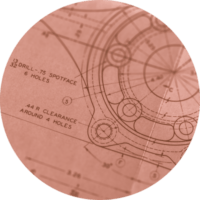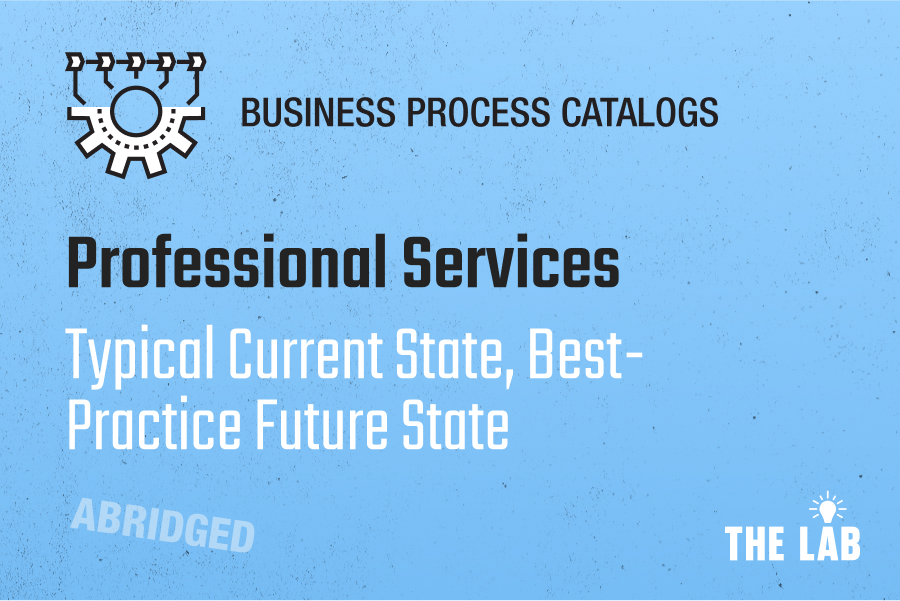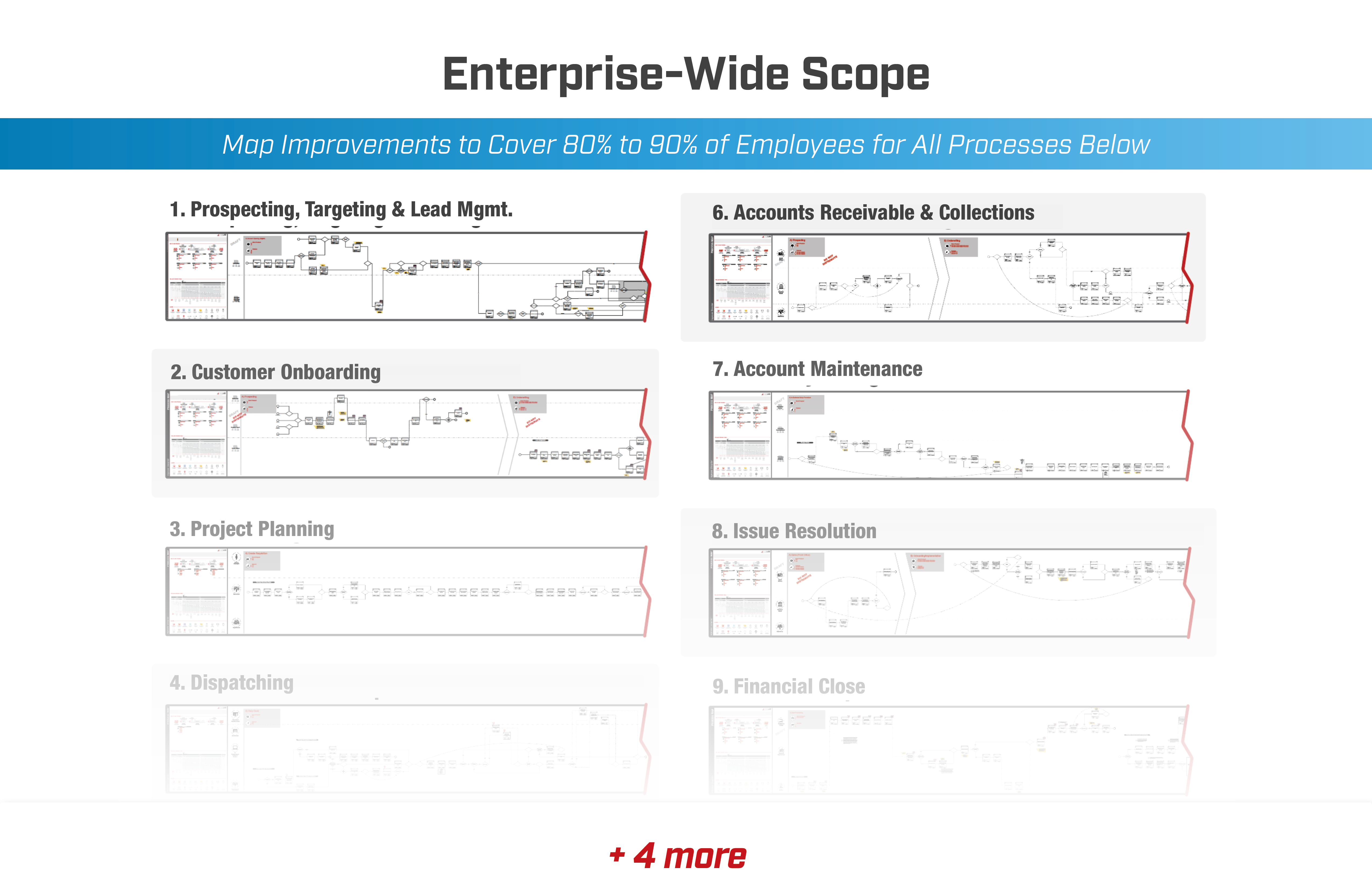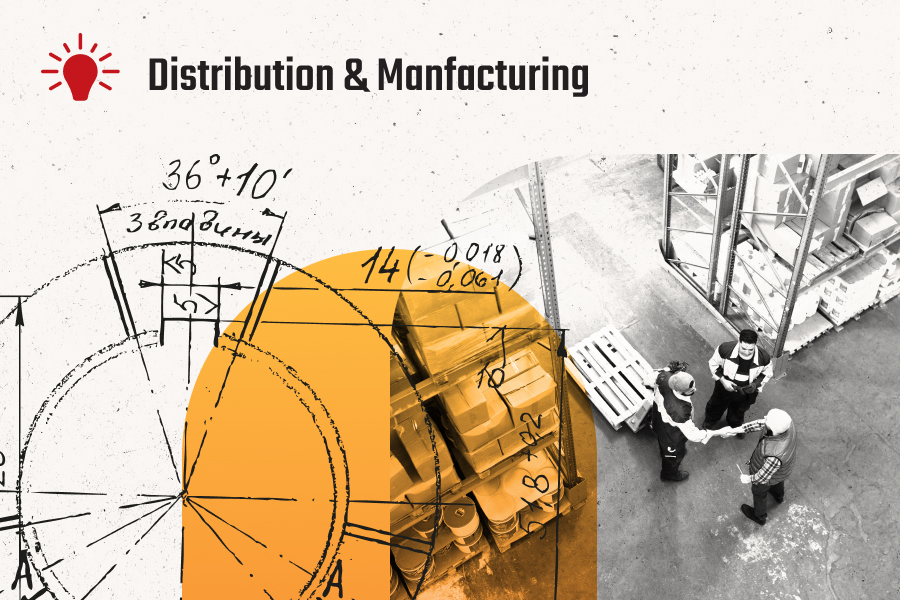Process Mapping and Improvement in Professional Services Firms
Process mapping in professional services must precede any other transformative strategic initiative, whether it’s continuous improvement, introduction (or expansion) of automation, or advanced analytics. You simply can’t move forward until you understand exactly what’s happening in your organization—and how it compares to best-practice processes that are active in the market today.
Before automation, analytics, or improvement—clarity on your processes is the key to sustainable change and competitive advantage.
Process Mapping: The Essential First Step for Professional Services Transformation
There’s a virtually limitless number of specialties for professional-services firms. That said, they have a lot in common. Whether you operate an oilfield services company, AEC, E&C, or CE firm, an outsourced HR organization, or any of countless others, know that process mapping should always be the first step on your strategic roadmap toward transformation, automation, continuous improvement, and analytics.
Three pressing root causes drive the need for process mapping and improvement in professional services to the top of any executive’s list:
- Disruptive effects continually take their toll. Changes—and limitations—in core technology (such as ERP, CRM, GIS, BIM, and others) affect your business. So do shifts in the macro-economic landscape, which heighten the demand for improvement. There are disruptions from M&A (merger and acquisition) activity. And then there are the regulatory changes that affect not just you, but your specialized clientele. And the more regulated their industries, the greater the impact on your business—and resulting need for process mapping and improvement in professional services.
- Hiding-in-plain-sight wasted effort is created by scores of idiosyncratic work methods which create up to 30 percent rates of inefficiency which plague professional-services firms every day. It’s a clear roadblock en route to improvement.
- Innovative competition is always looking for ways to disrupt your business; the aforementioned constraints provide an opportunistic upstart a way to enter your (and your clients’) industry, up-end it, and grab large chunks of market share.
Process mapping in professional services must precede any other transformative strategic initiative, whether it’s continuous improvement, introduction (or expansion) of automation, or advanced analytics. You simply can’t move forward until you understand exactly what’s happening in your organization—and how it compares to best-practice processes that are active in the market today.
How optimizing existing systems—without new tech investments—can boost efficiency, revenue, and margins in the near term.
Identify Hidden ROI: Drive Growth Through Process Mapping in Professional Services
As a C-suite executive at a professional services firm, you know how important operational efficiency is. You’re always searching for ways to increase revenue, profits, and enterprise value.
In this article, we will explore the benefits, services, and real-world examples of process mapping and improvement in professional services firms, showing how The Lab can help your firm improve operations, cross- and up-sell more client engagements and follow-on work, and improve margins—all in the near-term.
Some of the numbers speak for themselves. As just one example, we recently helped the CEO of a professional-services firm to:
- Reduce days sales outstanding or DSO on open invoices across the entire client and project base by more than 30 percent
- Increase billable hours by more than ten percent
- Reduce past-due invoices by more than 30 percent
How can we accomplish numbers like this, routinely, without the need for a costly technology upgrade at our professional-services-firm clients? One reason is that most of these firms have already invested heavily in database-driven technology systems—but have yet to exploit them to their full potential via increased operational improvement. As a result, there’s still ample ROI which can be squeezed from these existing systems.

A step-by-step explainer for mapping processes in professional services firms
How do you perform end-to-end process mapping in professional services?
In this long-form explanatory article about how to perform process mapping and improvement within professional services firms, we’ll take a deep dive into:
- The strategic opportunity underlying process mapping and improvement
- How to map the processes themselves
- Which tools you should—or shouldn’t—use
- Pitfalls you need to avoid
- Developing a benefit-rich process-improvement roadmap for your professional services firm
Following the guidance in this article, you could measurably improve gross margin, projects completed on-time/on-budget, and other strategic KPIs, in less than a year. That’s because The Lab has been helping professional services firms with our proven (and patented) approach since 1993.
Identifying inefficiencies in professional services
Charting the ideal future state for your firm through process mapping
Many people think of process mapping for professional-services firms as an exercise in documenting solely the company’s present state of operations. That misses perhaps the biggest opportunity of process mapping and improvement: the “improvement” part!
Wall-to-wall, end-to-end, activity-to-activity, department-to-department process mapping is the critical first step for your professional services firm. Whether delivered by a team in-house, or with the help of an external vendor/consulting partner, process mapping lets you visualize, analyze, and identify opportunities for future-state improvement, automation, and KPI measurement in all of your existing workflows. At the same time, by identifying inefficiencies and opportunities for standardization and improvement, it lets you attain a more valuable future state, wherein operational performance is maximized.
Process mapping, then, helps you to reduce costs, enhance client service, maximize the value of your firm’s existing technology investments, and drive greater value and improvement, enterprise-wide.
How do you define process mapping for AEC and other professional services firms?
Process mapping in professional services, defined and explained
When performed by The Lab, the definition of process mapping is: “A method for analyzing business workflows which visually depicts all of the steps required to perform a specific process in its entirety.”
The resulting flow-charts (or maps, or diagrams) provide a clear and graphical picture of how processes take place today—and how they can be improved in the future. Properly performed, process mapping breaks down even the most involved and multi-step tasks into easy-to-grasp (and manage) activities. It’s the requisite starting point for improving operations, efficiency, and customer service.
PROFESSIONAL SERVICES INDUSTRY: PROCESS IMPROVEMENT CATALOGS AND USE CASES FROM THE LAB'S LIBRARY
The Lab's Professional Services Firms Knowledge Base
What’s the right order for performing process mapping in my professional services firm?
The 3 key stages of process mapping in professional services
Broadly, the three key stages of process mapping are:
- Laying the groundwork. This includes the prioritization of strategic goals, building organizational buy-in, aligning the firm’s business need with the timing, and preparing the professional-services firm for the upcoming process improvement. This stage takes the most time, and requires the most effort and “political sensitivity.”
- Putting pen to paper. Drawing the actual process maps and creating written documentation of the identified improvements is the fastest and most enjoyable stage.
- Implementing the transformation roadmap of the improvements which have been prioritized by the organization. This is the longer-term, continuous-improvement stage, which makes good on the benefits identified in the business case.
process mapping in professional services
The 3 key stages in detail
How to create internal process-mapping capabilities?
Which internal (or external) teams should conduct business process mapping in professional services firms?
The largest professional services firms, across North America and the world, often rely on outside consulting firms to map their existing processes. These mapping activities are often triggered when implementing process improvements, merging organizations, or implementing new systems. Rarely do professional services firms possess a mature internal team which can perform organization-wide end-to-end business process mapping. The state of smaller/mid-sized firms mirrors that of their larger peers, with 70 percent lacking mature business-process-mapping capabilities that can manage enterprise-wide mapping initiatives.
For those professional services firms which have invested in internal improvement, their business-process-mapping teams are typically part of their internal improvement teams in the different business organizations. The most common job position for process-mapping is usually a business analyst or a process engineer. As your firm’s needs for data-driven process-improvement grow, seek out data scientists with process experience, and then back them into the traditional business analyst role. By contrast, process-mapping teams rarely reside within IT.
How do you source external process-mapping consultants for professional services?
Specialized process-mapping consulting services, such as those from The Lab Consulting, are effectively turnkey for professional services firms. We run the projects, we develop the maps, and we provide the teaching methods which we have deployed and honed at hundreds of other organizations and client engagements. The Lab Consulting has transformed our 30-plus years of process mapping into standardized tools and templates which we then use to accelerate process mapping for our clients.
Which software tools are best for business process mapping?
The best software and tools for business process mapping in professional services
The most popular tools are:
Microsoft Visio
- Easy to find and install; simply use MS Office 365
- Most popular process-mapping software for the past decade
Quick-erase and/or electronic whiteboards
- Great for fast, high-level summaries
- Often employed in group meetings for sketching summary flows
White or brown rolls of paper
- Handwritten/drawn diagrams with Post-it notes, typically hung on a wall
- Often used by traditional consultants
Signavio
- Cloud-based application
- Serves as an alternative to MS Visio
IBM Blueworks
- Proprietary process-mapping software from IBM
- Reduced presence/market share in recent years
The Lab’s 30-plus years of process-mapping experience
The Lab’s business process mapping/improvement strategy for professional services firms
The Lab’s unique approach to process improvement overcomes all the limitations of traditional methods. We deliver:

- Enhanced outcomes. By benchmarking your professional-services operations and customer journeys against industry best practices, we can identify competitive gaps. We can then design an improved future state for your business.
- More improvements. Understand all of your firm’s end-to-end processes at the activity level. This lets you identify avoidable rework, spot automation and AI opportunities and control points, and more.
- Increased benefits. Measure the precise capacity requirements of each business process or department. Create a benefits case to guide improvement implementation.
- Speedy analysis. Our process analysis is efficient by design. It requires just 1 hour per week of your staff’s time over a six- to eight-week period. This lets you focus on your core activities while we hone and validate our business process mapping and analysis.
Take a look at The Lab’s catalog of process maps created especially for professional services firms.
What is the scope of a best-practice project mapping initiative?
How The Lab scopes out process mapping and improvement for professional services firms
Given the diversity and specialization of clients and verticals they serve, you might be surprised to discover that business processes among professional-services firms are more similar than different. And that’s regardless of the size of the business.
Case in point: The key stage-gates and milestones of the project-management process at Professional Services Firm “A” will be about 80 percent similar to those at Firm “B.” This similarity renders the scoping of an engagement pretty straightforward for The Lab. Indeed, the biggest differences between Firms “A” and “B” will be the lack of standardization apparent at the system-level of the business, since each system’s workflows will have been configured differently by their original implementation teams.
Here are best practices to consider when scoping a process-mapping engagement in professional services:
- Seek out proven ROI by identifying a benefit-rich scope
- Map across all business departments and functions
- Avoid organizational silos
– Capture all phases of the customer journey, the sales process, the back-office operations steps, and all regulatory stage-gates. - Map out professional-services business processes from end-to-end. For example:
– Project management and execution from planning and forecasting all the way through field operations, setup, and rollout
– Billing and collections from T&E entry through invoice creation, collections, payment processing, and reporting - Make sure you get executive-level sponsorship, to avoid the prospect of internal organizations finding excuses to opt out
While the scope of process-mapping project will vary by professional-services organization, a common end-to-end example scope can be seen here:
Include every core and ancillary system in your process mapping
Why would you map just one department? You shouldn’t, of course. The same holds true for the systemsyour professional-services firm employs. Map every system, whether it’s a GIS, CAD, BIM, construction-management or estimating platform, or any other vertical-specific application. Don’t forget ancillary systems like your CRM, HRIS, and even MS Teams. And don’t overlook any data warehouses you use.
Defining workflows across all the systems used by your professional services firm will significantly increase the “lift” you receive from this end-to-end approach.
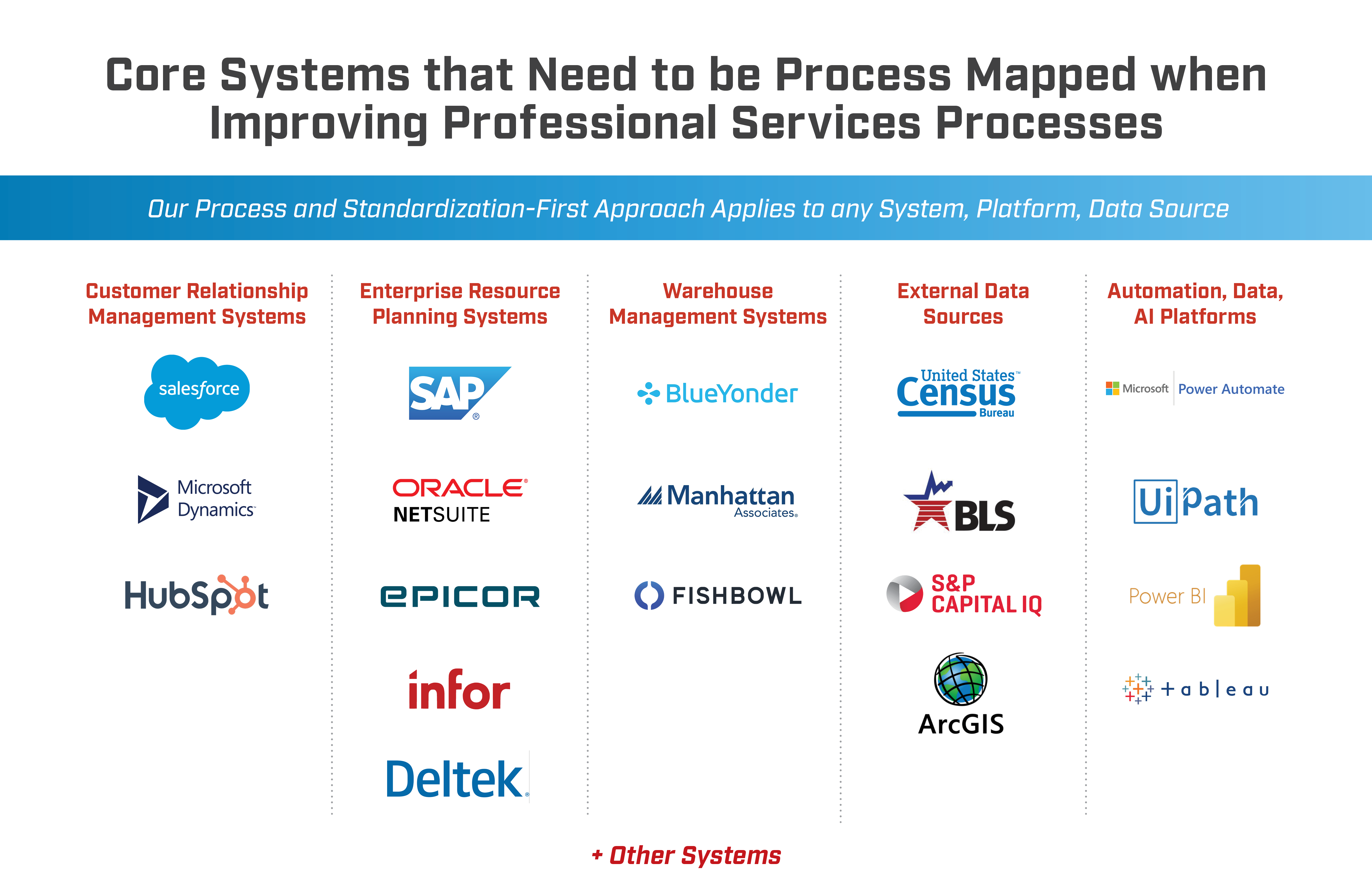
How does The Lab perform process mapping so rapidly?
How The Lab documents your professional services firm in 6-8 weeks
The Lab brings more than just a process-obsessed team to your professional services business process mapping and improvement project. We also bring our proven, standardized process-mapping approach and best-practice future-state templates. All of these combine to reduce the time it takes for us (and from you) to analyze and document your professional services business.
Here’s how we map your current-state processes in just 6 to 8 weeks:
- We document end-to-end business processes at the activity-level of detail: that is, one to five minutes in duration.
- Essential operations and improvement detail are added as a layer on top of each map.
- These layers include system use, job roles, customer touch-points, wasted effort, automation use-cases, standardization opportunities, and more.
At The Lab, our approach to process mapping makes sure that you needn’t “shut down your business to map your business.” At every step of the engagement, we’ll only need about one to two hours, per week, per subject matter expert.
We know that we can’t be a drag on your team; they would never work with us if we were! Besides, we recognize that your organization is already running flat out, just to keep the lights on.
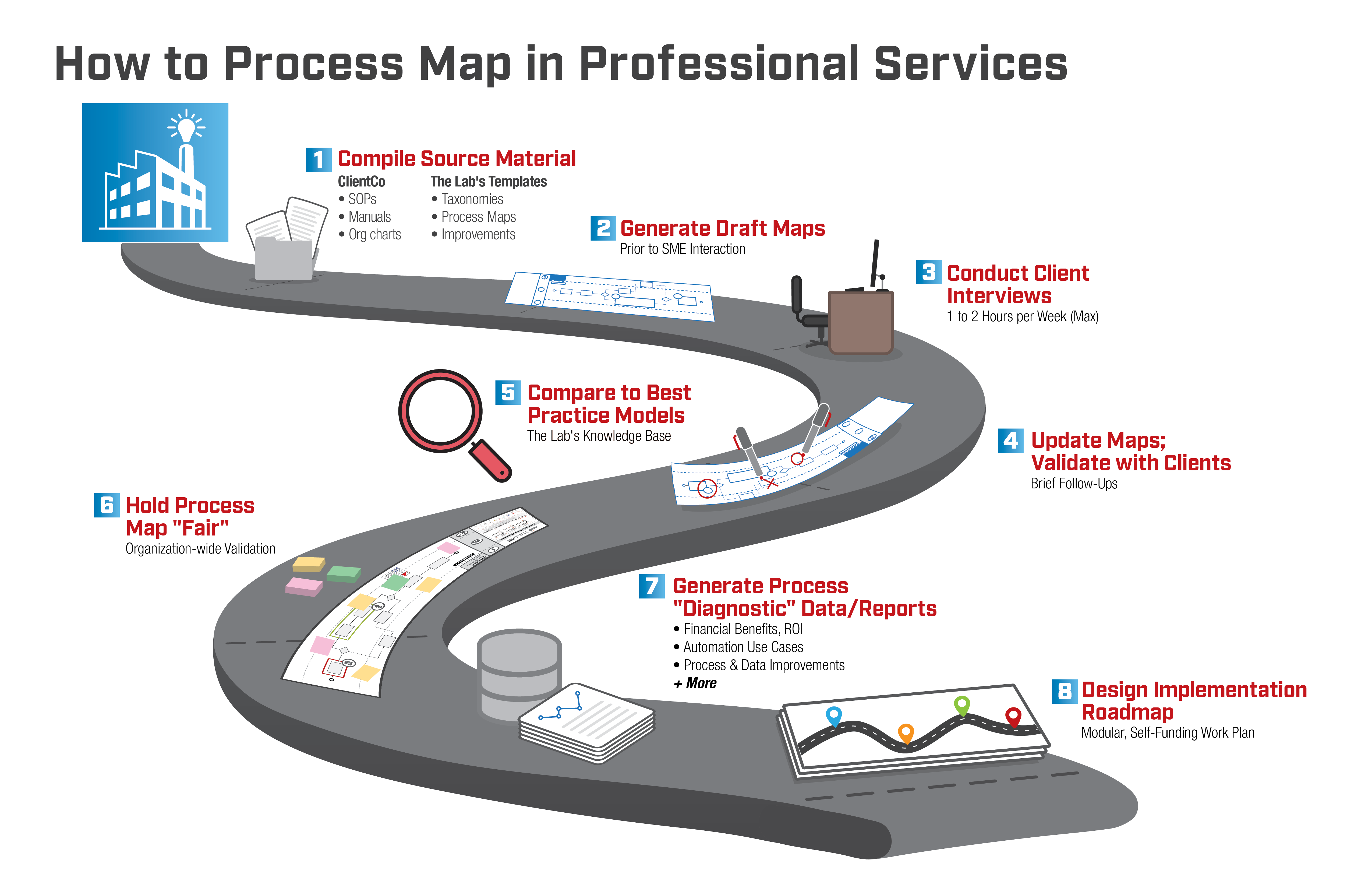
The 8 stages of process mapping in professional services firms
Here are the best-practice methodology and tempo The Lab follows during a business process mapping and improvement engagement for your professional services firm:
Stage 1:
We compile all of your data and source material
“Dump it on us! You can’t overload us!” That’s the exhortation you’ll hear from The Lab when we begin an engagement with your professional services firm. Give us your process information. Your manuals. Your policies and procedures.
They don’t have to be in pristine condition; to the contrary, they typically aren’t. We don’t care if the materials are half a dozen years old and/or incomplete. Regardless, we want to analyze all of your previous efforts at process documentation. This lets us do our research before we engage with your teams.
What do we want to review? We’ll ask you to share:
- Manuals
- SOPs
- Department and organization charts
- Operational reporting—even if your KPIs are buried in eye-glazing Excels or endless PowerPoint decks
But that’s not all. The Lab will also ask that you provide us with large-scale data extracts from all of your supporting systems. While this might seem like a cause for alarm (will sensitive data be at risk?), it isn’t. The Lab will only ask for redacted data, expunged of any PII and/or CSI. We don’t need (or even want) customer-sensitive data to find trends among KPIs such as:
- Project budget variance
- Days sales outstanding (DSO) on open invoices
- Percentage of work orders resolved with SLA
- Payment-processing rework
- Volume of not-in-good-order information moving through a billing or collection process
What happens next:
- The data is compared to the process maps
- It’s used to generate a current-state capacity model
- Importantly, it’s used to quantify the improvements for an implementation business case
After all, The Lab is, at its core, an implementation firm.
When we review the current-state materials which we receive from you, we’ll compare them to the data in our library and knowledge base of previously analyzed processes. Remember, your professional services firm isn’t that different from others, regardless of the industry you serve. This commonality will help us begin to plug gaps.
The Lab maintains a knowledge base packed with IP and templates, including:
- Process maps
- Taxonomies
- Improvements which include
– Automation use-cases for robotics
– KPIs (Key Performance Indicators)
– Standardization opportunities
– Reorganization
– Benchmarks
– Established best practices
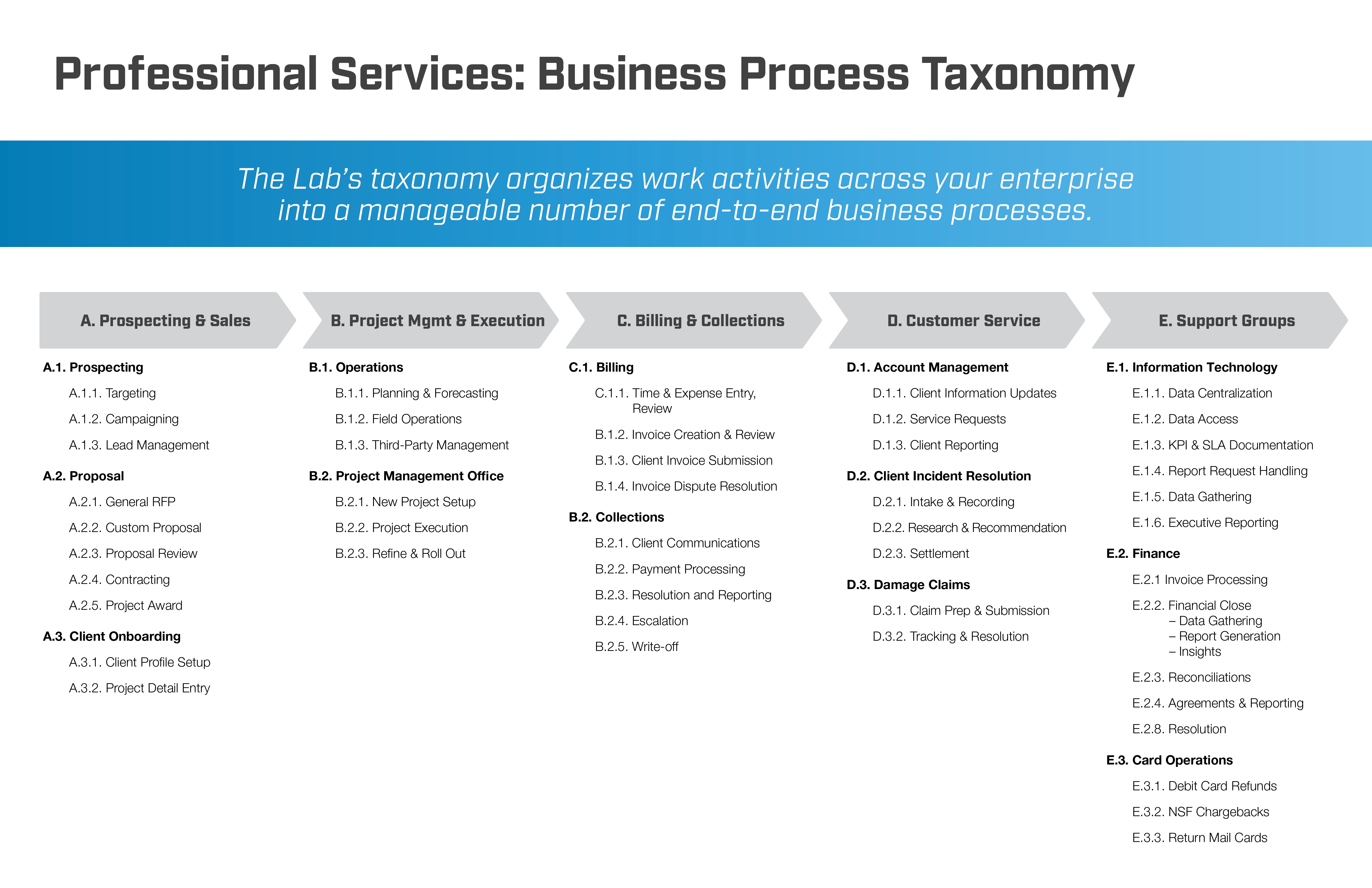
Stage 2:
The Lab creates Version 1 of the draft process maps
After requesting, receiving, ingesting, and processing all of the data from Stage 1, The Lab draws up the Version 1 process maps. Note that, even after all of this work, we still haven’t engaged with any of your SMEs yet. That’ because we want to be as frugal and respectful of their time as possible.
Speaking of respecting your time (and budget), that’s why The Lab does all of our process mapping in MS Visio. This lets you receive our maps, and update them as needed, after the engagement is over—without the time or expense of onboarding (or managing) yet another software vendor. Let’s face it: no matter how great our work is, nobody wants consultants hanging around their business forever!
Stage 3:
The Lab conducts interviews of your subject matter experts
After The Lab completes Version 1 of the business-process maps, it’s finally time for us to engage with your frontline subject matter experts (SMEs) who actually perform the daily tasks illustrated in the Version 1 maps. Using Zoom or Teams meetings, we present the Version 1 maps to these SMEs. We’ll pose pointed questions about the gaps we perceive in any given process. Tapping their expertise, we’ll build out further details. This entire activity only takes about one to two hours a week with your SMEs; as we’ve noted before, we want to be super respectful of their time.
Stage 4:
Update the process maps; iterate and validate
Over the course of the next four weeks (after the initial round of fact-gathering and process-mapping), we will work with your team and iterate the maps to build out more detail. We have discovered, in the course of our 30+ years of experience, that no professional-services-firm SME can ever remember every single step of a given process in one sitting. That’s why we come back, multiple times, to review the maps with the SMEs, in short bursts. Using this “lather-rinse-repeat” methodology, spread out over several weeks, builds out the best level of detail that the organization can then improve upon.
Stage 5:
Compare your validated, refined process map to those from peer firms and The Lab’s best-practice knowledge base
After we finish drafting the current-state business process maps for your organization, The Lab’s team then compares your maps to industry best-practice models. We’ll review peer comparatives. It’s a crucial step toward building out the most value-rich future state for implementation.
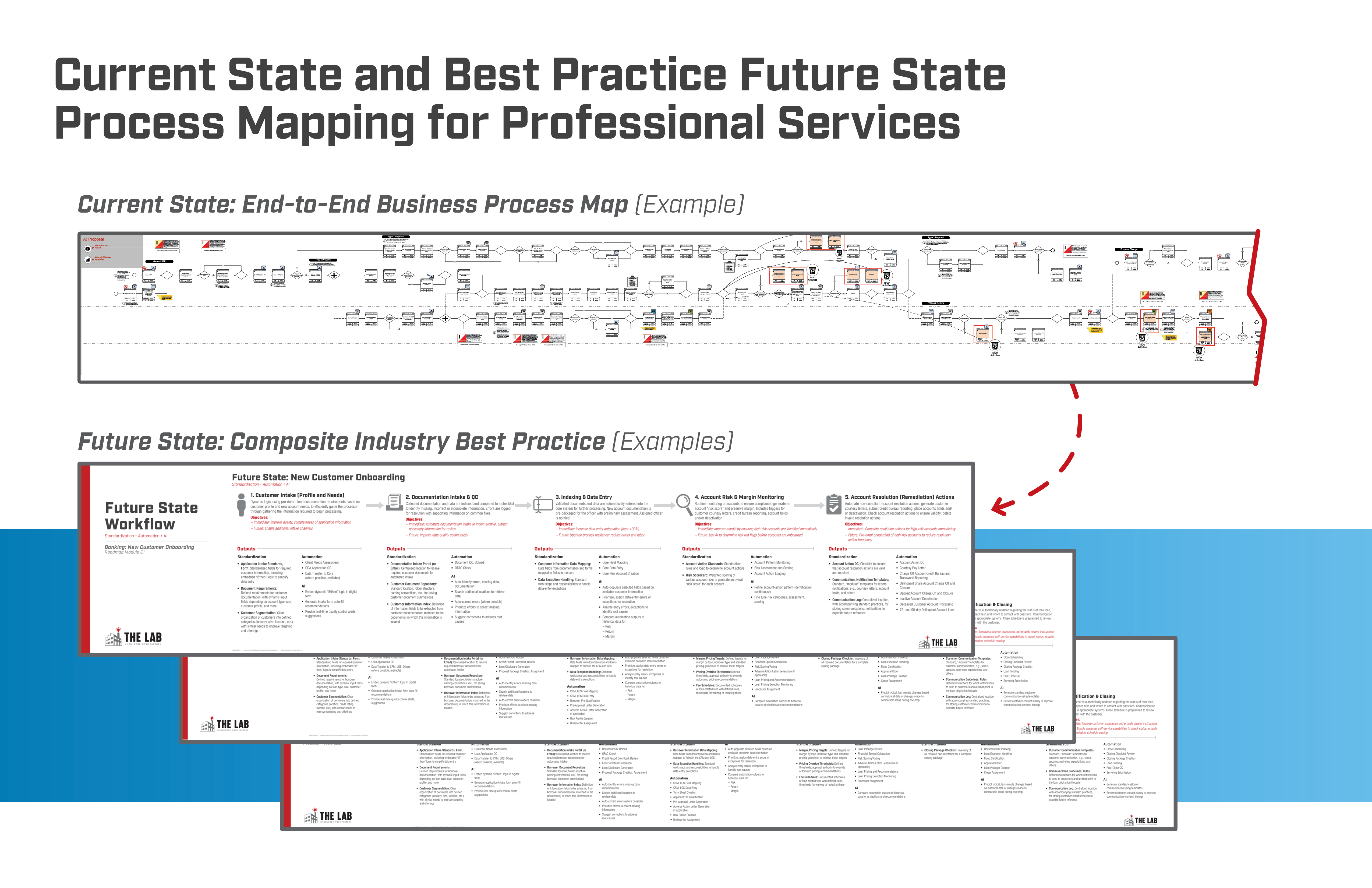
The Lab’s best-practice models and knowledge base include:
- KPIs
- Job descriptions
- Improvements
- Automation use-cases
- Benchmarks
- Process and data-standardization opportunities
- Opportunities for more productive reorganization
Stage 6:
Crowd-source improvement opportunities and gain organization-wide validation via a business-process “Map Fair”
Now comes the time to socialize all of the results generated to date. After The Lab completes the process maps, builds out detail with the help of SMEs, and validates them against our knowledge base, it’s time to bring the process maps to the entire organization.
These business-process “Map Fairs” are conducted live and in-person; they’re typically held in the organization’s headquarters, in common areas where staff can contribute at their leisure during a two-day “Map Fair” period.
Map Fairs allow the professional-services firm’s team members to contribute (anonymously, if they so choose) and further validate the process fact-base that the organization and The Lab have created together.
The Map Fair socializes the findings from the process-mapping work. It prepares the organization for upcoming process change. And it generates vital buy-in from team members by ensuring that everyone has an opportunity to contribute. Organization team members are encouraged to annotate the map with color-coded sticky notes:
- Green sticky notes mean “Spot-on: I agree strongly.”
- Yellow sticky notes mean “Here’s an additional process step or improvement that needs to be added” or “There’s missing information.”
- Red sticky notes mean “I strongly disagree.”
After completion of the Map Fair, The Lab analyzes all sticky note contributions, and reconciles them into a final version of the workflows. At this point, the business process maps are considered final.
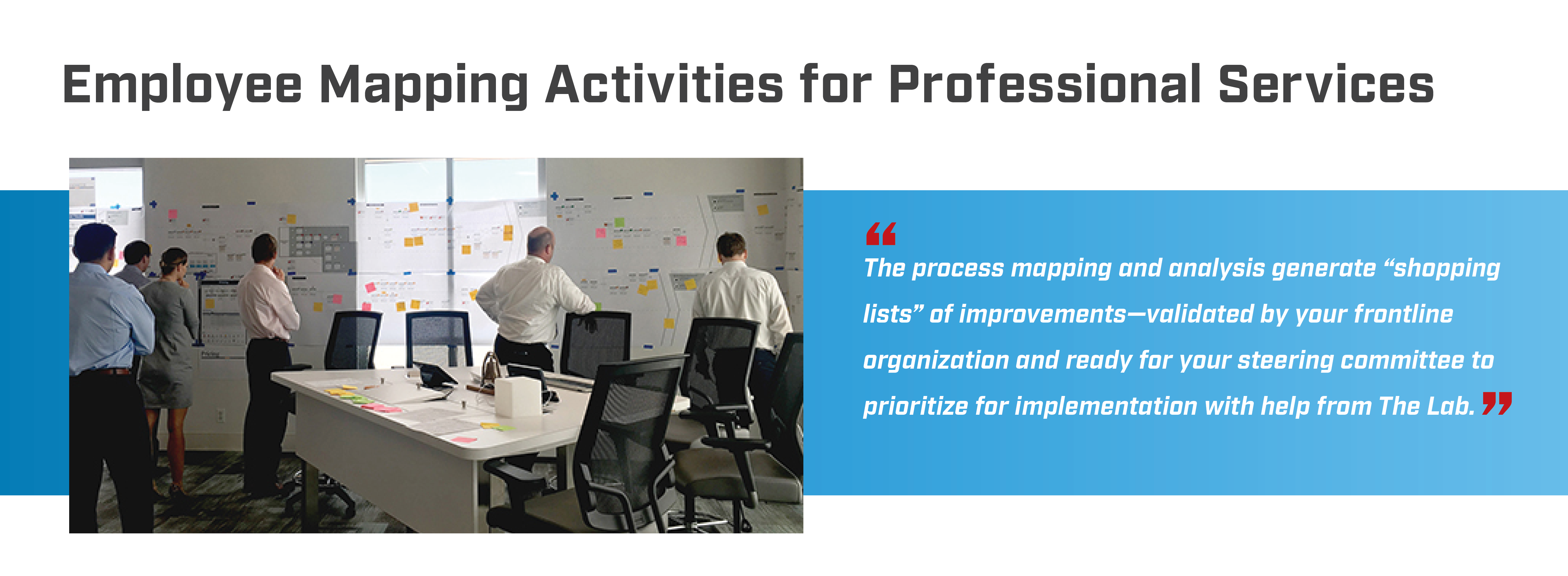
Stage 7:
Build the capacity model of your professional-services firm; generate reports
The Map Fair serves to analyze and validate the business process maps. And it paves the way for hundreds of improvements in your professional services organization. Consider some of these typical numbers:
- Uncover anywhere from 150 to 250 standardization opportunities
- Document anywhere from 50 to 100 analytics use cases
- Reveal anywhere from 100 to 200 automation use cases
Where do these go? The Lab wrangles them all into a navigable, centralized database—along with a Microsoft Power BI dashboard which is used to plan and prioritize which of the newly-uncovered improvement opportunities should be implemented, and in what order.
This triage is grounded in numbers. It’s quantified by:
- Measurable customer-experience improvement
- Financial benefits
- Time savings
- Platform and/or technology under-utilization
- Others
Based on this compilation and quantification of discrete improvements, The Lab can then generate a comprehensive organization capacity model which serves as a baseline for calculating the business case and value of implementation, work plans, and modules.
Outputs include:
- Process and data improvements
- Financial benefits, ROI
- Automation use-cases
- And many others
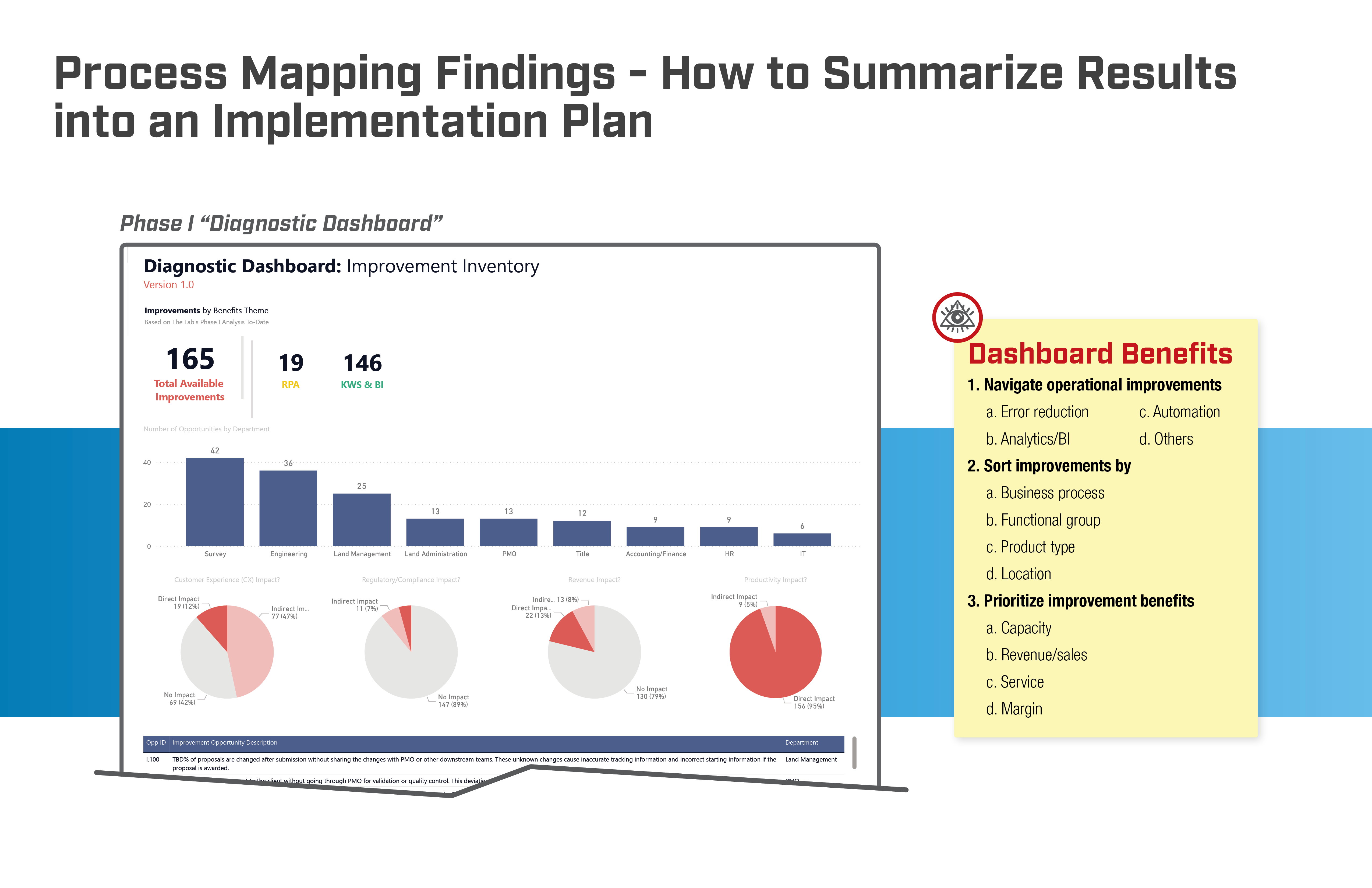
Stage 8:
Lay out the road map for improvements implementation
Even the most proficient professional services firm can’t implement all of the improvements that have been identified… at the same time. Trying to do so usually falls short of goals.
What we have learned over the years at The Lab, is that it’s far more efficient to create smaller, incremental implementation modules—aligned to a strategic plan in short, mid, and long-term segments. Initially, The Lab will help you with the implementation of the identified improvements. By the end, you’ll be able to do them on your own. This continuous-improvement approach always delivers more longer-term benefits than an aggressive all-in-one attempt.
Outputs from Stage 8 include:
- The complete modular—and self-funding—work plan
- This plan is jointly designed by The Lab and your executive steering committee to meet the professional services firm’s strategic objectives
- The plan’s schedule is laid out by business-calendar quarters
- The plan includes a mix of process improvements, robotic automation, and KPI analytics
Despite the “small and incremental” guidance we just mentioned, there are times when a big-bang approach is actually warranted. In fact, The Lab has supported some of the world’s biggest reorganizations when faced with the challenges that require such an approach.

How to save costs and increase operational efficiency and resilience
What are the 5 top benefits of business process mapping for professional service firms?
TRANSFORM YOUR PROFESSIONAL SERVICES OPERATION
Contact us today to book your demo!
The Lab has helped professional services firms’ C-suite execs, tech and business-unit leads, and internal improvement teams to map their companies’ business processes and client journeys, while enhancing client satisfaction/retention, streamlining operations, boosting efficiency, and attaining significant cost savings. We identify and implement automation opportunities and advanced analytics, improving process resiliency, while hedging against employee turnover. Our comprehensive solutions deliver measurable results and drive success.














